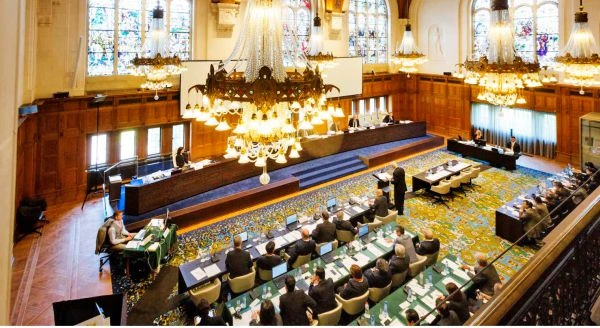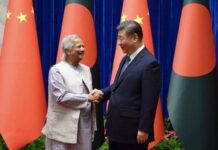China has been accused of using lawfare tactics to further its interests in other countries. Lawfare refers to the use of legal systems and processes as a means to advance strategic objectives.
Here are a few instances where China has been accused of leveraging lawfare:
South China Sea Dispute: China has used its legal interpretation of maritime law to assert sovereignty over vast portions of the South China Sea. In 2016, the Permanent Court of Arbitration in The Hague ruled in favor of the Philippines, invalidating China’s claims. However, China rejected the ruling and continued to fortify its positions in the disputed territories.
Intellectual Property Litigation: Chinese companies have been involved in numerous intellectual property disputes globally. In some cases, China has been accused of supporting or encouraging these companies to file lawsuits as a strategic move to gain access to foreign technologies or to create obstacles for foreign competitors.
Legal Actions against Dissidents: China has been known to target dissidents or activists living abroad through legal means. For example, Chinese authorities have used extradition requests, Interpol notices, and red notices to pressure foreign governments to detain and extradite individuals critical of the Chinese government.
Influence over International Organizations: China has been accused of using its economic and political clout to influence international organizations such as the United Nations and its specialized agencies. By leveraging its influence, China seeks to shape global norms, regulations, and policies that align with its interests and suppress criticism of its actions.
Foreign Investment and Commercial Contracts: China has been accused of using its economic leverage to dictate terms in foreign investment and commercial contracts. Critics argue that China’s state-owned enterprises and government-linked companies often engage in unfair trade practices, including forced technology transfer, intellectual property theft, and non-compliance with international business standards.
Belt and Road Initiative (BRI): China’s BRI has faced allegations of debt-trap diplomacy, wherein recipient countries become financially dependent on China and subsequently vulnerable to its influence. Some argue that China uses contractual obligations and legal mechanisms to secure its economic and strategic interests, sometimes at the expense of the sovereignty and long-term stability of partner countries.
Examples of Intellectual Property Litigations
Huawei vs. Samsung: In 2016, Huawei, a Chinese telecommunications company, filed lawsuits against Samsung, a South Korean multinational conglomerate, in multiple countries. Huawei alleged that Samsung infringed on its patents related to wireless communication, user interface, and software. The litigation resulted in cross-licensing agreements between the two companies.
Qualcomm vs. Meizu: Qualcomm, a global semiconductor and telecommunications equipment company, filed patent infringement lawsuits against Meizu, a Chinese smartphone manufacturer, in 2016. Qualcomm accused Meizu of using its patents without a license. The dispute was resolved in 2017 when Meizu agreed to pay licensing fees to Qualcomm.
Ericsson vs. Xiaomi: In 2014, Ericsson, a Swedish multinational networking and telecommunications company, filed a lawsuit against Xiaomi, a Chinese smartphone manufacturer. Ericsson claimed that Xiaomi violated its patents related to wireless communication technology. The companies eventually reached a settlement in 2016, which involved Xiaomi obtaining licenses for Ericsson’s standard-essential patents.
Dolby Laboratories vs. Chinese Manufacturers: Dolby Laboratories, an American audio technology company, has been involved in multiple intellectual property litigations with Chinese manufacturers. Dolby filed lawsuits against companies such as Oppo, Vivo, and OnePlus, accusing them of using its audio compression technologies without proper licensing. Several settlements have been reached between Dolby and the Chinese manufacturers.
Apple vs. Proview: In 2012, Apple was engaged in a trademark dispute with Proview, a Chinese technology company. Proview claimed that it owned the trademark for the term “iPad” in China and demanded compensation from Apple for trademark infringement. The case went through several court battles, and Apple eventually settled the dispute by paying Proview $60 million to acquire the iPad trademark rights in China.
Examples of Influencing International Organisations
United Nations Human Rights Council (UNHRC): China has been criticized for its efforts to influence the UNHRC. It has been accused of pressuring member states to refrain from criticizing its human rights record, particularly regarding issues such as Tibet, Xinjiang, and Hong Kong. China has also been known to support and promote resolutions that are favorable to its positions while attempting to suppress discussions on sensitive topics.
World Health Organization (WHO): China’s influence over the WHO has faced scrutiny, particularly in relation to the COVID-19 pandemic. There have been concerns about China’s transparency and its initial handling of the outbreak. China has been accused of exerting pressure to shape the WHO’s response and downplay the severity of the situation. These allegations have raised questions about the impartiality and independence of the organization.
International Telecommunication Union (ITU): China has been active within the ITU, a specialized agency of the United Nations responsible for information and communication technologies. It has sought to shape international telecommunications standards and policies in ways that align with its own technological interests. China has pushed for its own technology companies, such as Huawei, to be included in global telecommunications networks, despite concerns about security risks.
United Nations Economic and Social Council (ECOSOC): China has sought to increase its influence within ECOSOC, which focuses on economic and social issues. China has been known to promote its own development models and advocate for policies that advance its economic interests. It has also been accused of using its financial resources to gain influence and support from other member states.
International organizations related to trade and finance: China’s influence can be observed in various international organizations related to trade and finance, including the World Trade Organization (WTO) and the International Monetary Fund (IMF). China has sought to shape trade rules, promote its own economic initiatives like the Belt and Road Initiative, and increase its voting power and decision-making influence within these organizations.
Classic Hambantota Port Debt Trap
One example often cited as a potential instance of a BRI debt trap is the case of the Hambantota Port in Sri Lanka. In 2017, Sri Lanka handed over control of the strategically located port to China Merchants Port Holdings, a state-owned enterprise, under a 99-year lease agreement. This transfer of control came as a result of Sri Lanka’s inability to repay the loans it had obtained from China to finance the construction of the port.
Critics argue that the terms of the initial loan and subsequent negotiations heavily favored China and placed Sri Lanka in a precarious debt situation. Here are some key aspects of the Hambantota Port agreement:
High Debt Burden: Sri Lanka had borrowed approximately $1.3 billion from China to build the port. The high-interest rates and short repayment periods associated with the loan made it challenging for Sri Lanka to meet its financial obligations.
Debt Restructuring: When Sri Lanka struggled to repay the loan, it entered into negotiations with China to restructure the debt. Ultimately, the agreement resulted in China gaining control of the port through a 99-year lease. This move was seen by critics as a means for China to secure a strategic foothold in the Indian Ocean region.
Strategic Concerns: The Hambantota Port is strategically located near major shipping routes and holds potential military significance. Concerns have been raised that China’s control over the port could have implications for regional security dynamics, granting China greater influence and potentially challenging the interests of other countries.
While the Hambantota Port case is often cited as an example of a potential BRI debt trap, it’s important to note that debt traps are not universal outcomes of BRI projects. Many BRI initiatives have been implemented successfully, contributing to infrastructure development and economic growth in participating countries. However, the Hambantota Port case has raised concerns about the potential risks associated with the financial arrangements and debt burdens in certain BRI projects.
======================
China’s Strategic ‘Lawfare’ Against Bhutan and Arunachal
On 13 January 2023, the Chinese and Bhutanese delegations met for the 11th Expert Group Meeting on the China-Bhutan Boundary Issues. Here, the two sides signed a Memorandum of Understanding (MoU) on ‘Accelerating the Three-Step Roadmap for China-Bhutan Border Negotiations’.
Bhutanese Prime Minister Lotay Tshering told Belgian newspaper La Libre Belgique that China is a party to the Doklam tri-junction border dispute. In the interview, Tshering also brushed aside all concerns about Beijing constructing villages inside Bhutanese territory – worrying many in India. Tshering said that Thimphu would be ready to settle its territorial dispute with Beijing after a few meetings.
But even if Beijing and Thimphu can settle their dispute over non-Doklam areas, China isn’t planning to stop claiming the Doklam tri-junction area.
Beijing’s latest lawfare move aims to rename 11 locations in Arunachal Pradesh – approved by the State Council and likely based on recommendations by the Chinese Academy of Social Sciences. The Chinese names assigned to the 11 locations in Arunachal Pradesh are mostly direct transliterations from Tibetan and not new ones. China considers the 11 places in Arunachal Pradesh to be a part of southern Tibet, which it calls Zangnan.
“Zangnan is part of China’s territory. In accordance with relevant stipulations of the administration of geographical names of the State Council, competent authorities of the Chinese government have standardised the names of some parts of Zangnan. This is within China’s sovereign rights,” said Mao Ning, Chinese foreign ministry spokesperson.


















